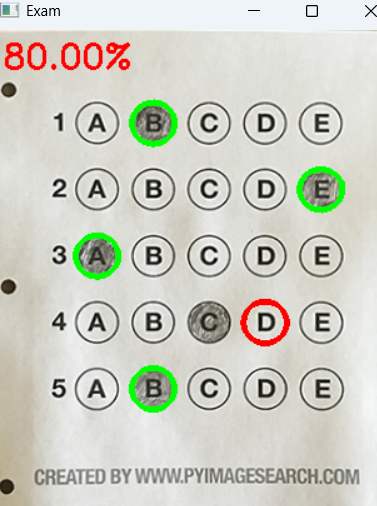利用OpenCV进行对答题卡上的答案进行识别的案例
代码实现:
import cv2
import numpy as npANSWER_KEY = {0:1,1:4,2:0,3:3,4:1}def cv_show(name,img):cv2.imshow(name,img)cv2.waitKey(0)def order_points(pts):# 一共有4个坐标点rect = np.zeros((4, 2), dtype="float32") # 用来存储排序之后的坐标位置# 按顺序找到对应坐标0123分别是 左上,右上,右下,左下s = pts.sum(axis=1) # 对pts矩阵的每一行进行求和操作,(x+y)rect[0] = pts[np.argmin(s)]rect[2] = pts[np.argmax(s)]diff = np.diff(pts, axis=1) # 对pts矩阵的每一行进行求差操作,(y-x)rect[1] = pts[np.argmin(diff)]rect[3] = pts[np.argmax(diff)]return rect
def four_point_transform(image, pts):# 获取输入坐标点rect = order_points(pts)(tl, tr, br, bl) = rect# 计算输入的w和h值widthA = np.sqrt(((br[0] - bl[0]) ** 2) + ((br[1] - bl[1]) ** 2))widthB = np.sqrt(((tr[0] - tl[0]) ** 2) + ((tr[1] - tl[1]) ** 2))maxWidth = max(int(widthA), int(widthB))heightA = np.sqrt(((tr[0] - br[0]) ** 2) + ((tr[1] - br[1]) ** 2))heightB = np.sqrt(((tl[0] - bl[0]) ** 2) + ((tl[1] - bl[1]) ** 2))maxHeight = max(int(heightA), int(heightB))# 变换后对应坐标位置dst = np.array([[0, 0], [maxWidth - 1, 0],[maxWidth - 1, maxHeight - 1], [0, maxHeight - 1]], dtype="float32")# 图像透视变换:获取透视变换矩阵 + 应用变换M = cv2.getPerspectiveTransform(rect, dst)warped = cv2.warpPerspective(image, M, (maxWidth, maxHeight))# 返回变换后结果return warped
def sort_contours(cnts, method='left-to-right'):reverse = Falsei = 0if method == 'right-to-left' or method == 'bottom-to-top':reverse = Trueif method == 'top-to-bottom' or method == 'bottom-to-top':i = 1boundingBoxes = [cv2.boundingRect(c) for c in cnts](cnts, boundingBoxes) = zip(*sorted(zip(cnts, boundingBoxes),key=lambda b: b[1][i], reverse=reverse))return cnts, boundingBoxesimage = cv2.imread('test_01.png')
contours_img = image.copy()
gray = cv2.cvtColor(image,cv2.COLOR_BGR2GRAY)
blurred = cv2.GaussianBlur(gray,(5,5),0)
cv_show('blurred',blurred)
edged = cv2.Canny(blurred,75,200)
cv_show('edged',edged)
# 铊廓检測
cnts = cv2.findContours(edged.copy(),cv2.RETR_EXTERNAL,cv2.CHAIN_APPROX_SIMPLE)[-2]
cv2.drawContours(contours_img,cnts,-1,(0,0,255),3)
cv_show('contours_img',contours_img)
docCnt = None
# 根据轮席大小进行排序,准备透视变换
cnts = sorted(cnts,key=cv2.contourArea,reverse=True)
for c in cnts:peri = cv2.arcLength(c,True)approx = cv2.approxPolyDP(c,0.02*peri,True)if len(approx) == 4:docCnt = approxbreak# 执行透视变换
warped_t = four_point_transform(image,docCnt.reshape(4,2))
warped_new = warped_t.copy()
cv_show('warped',warped_t)
warped = cv2.cvtColor(warped_t,cv2.COLOR_BGR2GRAY)
#闽值处理
thresh = cv2.threshold(warped,0,255,cv2.THRESH_BINARY_INV|cv2.THRESH_OTSU)[1]
cv_show('thresh',thresh)
thresh_Contours = thresh.copy()
# 找到每一个圆圈轮廓
cnts = cv2.findContours(thresh,cv2.RETR_EXTERNAL,cv2.CHAIN_APPROX_SIMPLE)[-2]
warped_Contours = cv2.drawContours(warped_t,cnts,-1,(0,255,0),1)
cv_show('warped_Contouts',warped_Contours)questionsCnts = []
for c in cnts:(x,y,w,h) = cv2.boundingRect(c)ar = w / float(h)if w >= 20 and h >= 20 and 0.9<=ar<=1.1:questionsCnts.append(c)
print(len(questionsCnts))questionsCnts = sort_contours(questionsCnts,method='top-to-bottom')[0]
correct = 0
for (q,i) in enumerate(np.arange(0,len(questionsCnts),5)):cnts = sort_contours(questionsCnts[i:i+5])[0]bubbled = Nonefor (j,c) in enumerate(cnts):mask = np.zeros(thresh.shape,dtype='uint8')cv2.drawContours(mask,[c],-1,255,-1)cv_show('mask',mask)thresh_mask_and = cv2.bitwise_and(thresh,thresh,mask=mask)cv_show('thresh_mask_and',thresh_mask_and)total = cv2.countNonZero(thresh_mask_and)if bubbled is None or total > bubbled[0]:bubbled = (total,j)color = (0,0,255)k = ANSWER_KEY[q]if k == bubbled[1]:color = (0,255,0)correct += 1cv2.drawContours(warped_new,[cnts[k]],-1,color,3)cv_show('warpeding',warped_new)
score = ( correct / 5.0)*100
print("[INF0]score:{:.2f}%".format(score))
cv2.putText(warped_new,"{:.2f}%".format(score),(10,30),cv2.FONT_HERSHEY_SIMPLEX,0.9,(0,0,255),2)
cv2.imshow("Original",image)
cv2.imshow("Exam",warped_new)
cv2.waitKey(0)这段代码是一个基于 OpenCV 的选择题自动批改程序,能够识别答题卡上的填涂选项并与标准答案对比,最终计算得分。下面分步骤解析代码的核心功能和实现逻辑:
1. 核心库与参数定义
import cv2 # 图像处理库
import numpy as np # 数值计算库ANSWER_KEY = {0:1,1:4,2:0,3:3,4:1} # 标准答案:键为题目序号,值为正确选项索引(0-4对应A-E)
2. 自定义工具函数
这些函数是后续图像处理的核心工具:
(1)图像显示函数 cv_show
def cv_show(name,img):cv2.imshow(name,img) # 显示图像cv2.waitKey(0) # 等待按键(0表示无限等待)
作用:简化图像显示操作,方便中间结果查看。
(2)四边形顶点排序 order_points
def order_points(pts):rect = np.zeros((4, 2), dtype="float32") # 存储排序后的4个顶点s = pts.sum(axis=1) # 计算每个点的x+y之和rect[0] = pts[np.argmin(s)] # 左上:x+y最小rect[2] = pts[np.argmax(s)] # 右下:x+y最大diff = np.diff(pts, axis=1) # 计算每个点的y-x差值rect[1] = pts[np.argmin(diff)] # 右上:y-x最小(x-y最大)rect[3] = pts[np.argmax(diff)] # 左下:y-x最大(x-y最小)return rect
作用:将四边形的 4 个顶点按「左上→右上→右下→左下」顺序排列,为透视变换做准备。
(3)透视变换 four_point_transform
def four_point_transform(image, pts):rect = order_points(pts) # 排序顶点(tl, tr, br, bl) = rect # 解包顶点# 计算变换后图像的宽高(取最大值确保覆盖所有区域)widthA = np.sqrt(((br[0]-bl[0])**2)+((br[1]-bl[1])**2)) # 下边长widthB = np.sqrt(((tr[0]-tl[0])**2)+((tr[1]-tl[1])**2)) # 上边长maxWidth = max(int(widthA), int(widthB))heightA = np.sqrt(((tr[0]-br[0])**2)+((tr[1]-br[1])**2)) # 右边长heightB = np.sqrt(((tl[0]-bl[0])**2)+((tl[1]-bl[1])**2)) # 左边长maxHeight = max(int(heightA), int(heightB))# 目标图像的4个顶点(正视图)dst = np.array([[0,0], [maxWidth-1,0], [maxWidth-1,maxHeight-1], [0,maxHeight-1]], dtype="float32")# 计算透视变换矩阵并应用M = cv2.getPerspectiveTransform(rect, dst) # 变换矩阵warped = cv2.warpPerspective(image, M, (maxWidth, maxHeight)) # 透视变换return warped
作用:将倾斜的答题卡(四边形)矫正为正视图,方便后续按顺序识别选项。
(4)轮廓排序 sort_contours
def sort_contours(cnts, method='left-to-right'):reverse = False # 是否反向排序i = 0 # 排序依据的维度(0为x坐标,1为y坐标)if method in ['right-to-left', 'bottom-to-top']:reverse = Trueif method in ['top-to-bottom', 'bottom-to-top']:i = 1 # 按y坐标排序(上下方向)# 按边界框的指定维度排序boundingBoxes = [cv2.boundingRect(c) for c in cnts] # 每个轮廓的边界框(x,y,w,h)(cnts, boundingBoxes) = zip(*sorted(zip(cnts, boundingBoxes),key=lambda b: b[1][i], reverse=reverse))return cnts, boundingBoxes
作用:按指定方向(如从上到下、从左到右)排序轮廓,确保题目和选项按顺序处理。
3. 主流程:答题卡识别与批改
(1)图像预处理
image = cv2.imread('test_01.png') # 读取原始图像
contours_img = image.copy() # 复制图像用于绘制轮廓
gray = cv2.cvtColor(image, cv2.COLOR_BGR2GRAY) # 转为灰度图
blurred = cv2.GaussianBlur(gray, (5,5), 0) # 高斯模糊降噪
edged = cv2.Canny(blurred, 75, 200) # Canny边缘检测(提取边缘)
目的:简化图像,突出轮廓边缘,为后续轮廓检测做准备。
(2)检测答题卡边界
# 检测所有外轮廓
cnts = cv2.findContours(edged.copy(), cv2.RETR_EXTERNAL, cv2.CHAIN_APPROX_SIMPLE)[-2]
cv2.drawContours(contours_img, cnts, -1, (0,0,255), 3) # 绘制轮廓(红色)# 筛选出答题卡的矩形轮廓(面积最大的四边形)
docCnt = None
cnts = sorted(cnts, key=cv2.contourArea, reverse=True) # 按面积降序排序
for c in cnts:peri = cv2.arcLength(c, True) # 计算轮廓周长approx = cv2.approxPolyDP(c, 0.02*peri, True) # 轮廓近似(多边形拟合)if len(approx) == 4: # 若近似为四边形(答题卡通常是矩形)docCnt = approxbreak
目的:从图像中定位答题卡的边界(假设答题卡是最大的四边形)。
(3)透视变换矫正答题卡
# 对答题卡进行透视变换,得到正视图
warped_t = four_point_transform(image, docCnt.reshape(4,2)) # 彩色正视图
warped_new = warped_t.copy() # 用于后续绘制批改结果
warped = cv2.cvtColor(warped_t, cv2.COLOR_BGR2GRAY) # 转为灰度正视图# 阈值处理:将填涂区域转为白色,背景为黑色(反二进制阈值)
thresh = cv2.threshold(warped, 0, 255, cv2.THRESH_BINARY_INV | cv2.THRESH_OTSU)[1]
目的:将倾斜的答题卡矫正为平整的正视图,并用阈值处理突出填涂区域(填涂部分为白色)。
(4)识别选项轮廓(圆圈)
# 检测阈值图像中的轮廓(候选选项)
cnts = cv2.findContours(thresh, cv2.RETR_EXTERNAL, cv2.CHAIN_APPROX_SIMPLE)[-2]
warped_Contours = cv2.drawContours(warped_t, cnts, -1, (0,255,0), 1) # 绘制选项轮廓(绿色)# 筛选出符合条件的选项轮廓(大小接近正方形的圆圈)
questionsCnts = []
for c in cnts:(x,y,w,h) = cv2.boundingRect(c) # 轮廓的边界框ar = w / float(h) # 长宽比# 筛选:宽度和高度≥20像素,且长宽比接近1(正方形)if w >= 20 and h >= 20 and 0.9 <= ar <= 1.1:questionsCnts.append(c)
目的:从图像中筛选出选项的圆圈轮廓(排除无关的小轮廓或干扰区域)。
(5)识别填涂选项并批改
# 按从上到下排序选项轮廓(对应题目顺序)
questionsCnts = sort_contours(questionsCnts, method='top-to-bottom')[0]
correct = 0 # 正确题数# 遍历每个题目(假设每题5个选项,按顺序每5个轮廓为一组)
for (q, i) in enumerate(np.arange(0, len(questionsCnts), 5)):# 对当前题目的5个选项按从左到右排序(A→E)cnts = sort_contours(questionsCnts[i:i+5])[0]bubbled = None # 存储被填涂的选项# 计算每个选项的填涂面积(非零像素数)for (j, c) in enumerate(cnts):mask = np.zeros(thresh.shape, dtype='uint8') # 创建掩码cv2.drawContours(mask, [c], -1, 255, -1) # 将当前选项轮廓内填白# 计算掩码与阈值图像的交集(即填涂区域)thresh_mask_and = cv2.bitwise_and(thresh, thresh, mask=mask)total = cv2.countNonZero(thresh_mask_and) # 非零像素数(填涂面积)# 记录填涂面积最大的选项(认为是被选中的选项)if bubbled is None or total > bubbled[0]:bubbled = (total, j)# 与标准答案对比color = (0,0,255) # 默认为红色(错误)k = ANSWER_KEY[q] # 该题的正确选项索引if k == bubbled[1]: # 若选中的选项正确color = (0,255,0) # 改为绿色(正确)correct += 1# 在图像上标记正确选项的轮廓cv2.drawContours(warped_new, [cnts[k]], -1, color, 3)
核心逻辑:通过掩码计算每个选项的填涂面积,面积最大的即为选中项;与标准答案对比,正确则标记绿色,错误标记红色。
(6)计算并显示分数
# 计算得分(正确率×100)
score = (correct / 5.0) * 100
print("[INFO] score: {:.2f}%".format(score))# 在图像上显示分数
cv2.putText(warped_new, "{:.2f}%".format(score), (10,30), cv2.FONT_HERSHEY_SIMPLEX, 0.9, (0,0,255), 2)# 显示最终结果
cv2.imshow("Original", image) # 原始图像
cv2.imshow("Exam", warped_new) # 批改后的答题卡
cv2.waitKey(0)
最终效果图:

总结
整个流程从「图像预处理→答题卡定位→透视矫正→选项识别→填涂判断→分数计算」,通过 OpenCV 的轮廓检测、透视变换等技术,实现了选择题的自动批改。核心是通过轮廓排序和填涂面积分析,准确识别选中的选项,并与标准答案对比。
